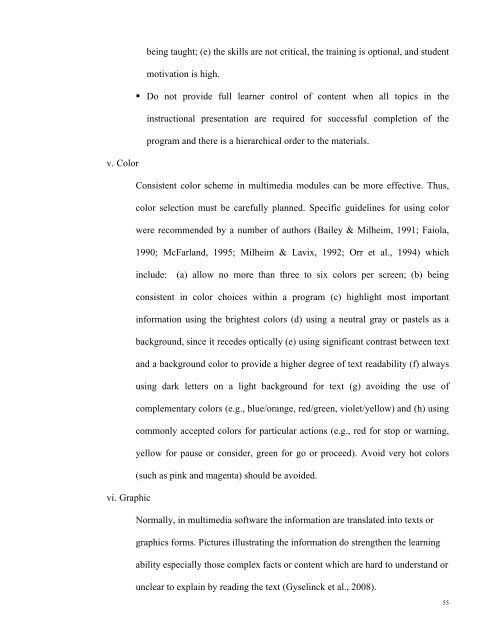Chapter 4 Data Collection, Analysis and Findings - DSpace@UM
Chapter 4 Data Collection, Analysis and Findings - DSpace@UM
Chapter 4 Data Collection, Analysis and Findings - DSpace@UM
You also want an ePaper? Increase the reach of your titles
YUMPU automatically turns print PDFs into web optimized ePapers that Google loves.
eing taught; (e) the skills are not critical, the training is optional, <strong>and</strong> student<br />
motivation is high.<br />
• Do not provide full learner control of content when all topics in the<br />
instructional presentation are required for successful completion of the<br />
program <strong>and</strong> there is a hierarchical order to the materials.<br />
v. Color<br />
Consistent color scheme in multimedia modules can be more effective. Thus,<br />
color selection must be carefully planned. Specific guidelines for using color<br />
were recommended by a number of authors (Bailey & Milheim, 1991; Faiola,<br />
1990; McFarl<strong>and</strong>, 1995; Milheim & Lavix, 1992; Orr et al., 1994) which<br />
include:<br />
(a) allow no more than three to six colors per screen; (b) being<br />
consistent in color choices within a program (c) highlight most important<br />
information using the brightest colors (d) using a neutral gray or pastels as a<br />
background, since it recedes optically (e) using significant contrast between text<br />
<strong>and</strong> a background color to provide a higher degree of text readability (f) always<br />
using dark letters on a light background for text (g) avoiding the use of<br />
complementary colors (e.g., blue/orange, red/green, violet/yellow) <strong>and</strong> (h) using<br />
commonly accepted colors for particular actions (e.g., red for stop or warning,<br />
yellow for pause or consider, green for go or proceed). Avoid very hot colors<br />
(such as pink <strong>and</strong> magenta) should be avoided.<br />
vi. Graphic<br />
Normally, in multimedia software the information are translated into texts or<br />
graphics forms. Pictures illustrating the information do strengthen the learning<br />
ability especially those complex facts or content which are hard to underst<strong>and</strong> or<br />
unclear to explain by reading the text (Gyselinck et al., 2008).<br />
55

















